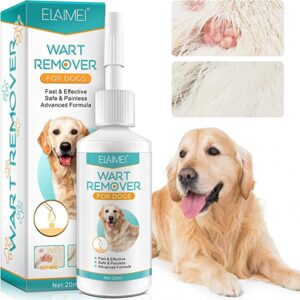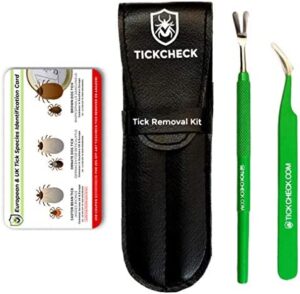How Can I Tell If Its a Tick or a Skin Tag on my Dog?

Photo by Mathieu Gervais:
Introduction to Ticks and Skin Tags on Dogs
Ticks and skin tags are two common issues dogs may encounter. Ticks are blood-sucking parasites that attach to a dog’s skin, while skin tags are benign growths that usually appear on its surface.
Ticks carry health risks like Lyme disease, anaplasmosis, and Rocky Mountain spotted fever; on the other hand, skin tags usually don’t cause harm and require no treatment unless they cause discomfort to the canine.
Ticks are typically found in tall grass, wooded areas, and bushes. These pests can latch onto a dog’s fur and then make their way onto their skin; thus, regularly checking your pup for ticks can lead to serious health problems if left untreated.
Skin tags, on the other hand, are harmless growths that can appear on a dog’s skin. Usually harmless and without medical intervention, they don’t cause any discomfort or interfere with daily activities; however, if they become an issue for your pup, they may be surgically removed to alleviate their discomfort or inconvenience.
Overall, ticks and skin tags can cause your dog discomfort. To ensure their well-being, regularly inspect their fur for abnormalities and seek veterinary help if required. You can help keep your furry friend healthy and content with proper attention and care.
Understanding Ticks: Types, Life Cycle, and Health Risks for Dogs
Ticks are parasitic arachnids that feed on the blood of animals, including dogs. Different species of ticks exist, such as the American dog tick, brown dog tick and black-legged tick. Each tick species can transmit dog diseases, such as Lyme disease, Rocky Mountain spotted fever and Ehrlichiosis.
Ticks go through four life stages: egg, larva, nymph and adult. Depending on their species and environment, ticks can live for years or even decades, depending on their food sources. Each stage requires blood feeding to survive and reproduce successfully.
Ticks can attach to dogs through various means, such as grass, bushes or contact with other animals. Once attached, ticks may remain to feed on your pup’s blood supply for several days, which poses health risks like anemia, skin irritation and the potential transmission of diseases.
Preventative measures are necessary to protect your dog from ticks, such as regular grooming, taking tick prevention medication and avoiding tick-infested areas. If a tick appears on your pup, remove it properly and seek veterinary help if needed.
Understanding the types, life cycles, and potential health hazards associated with ticks can help keep your pup healthy and contented.
Hartz UltraGuard ProMax Flea & Tick Collar for Dogs
Identifying Skin Tags: Appearance, Location, and Causes in Dogs
Skin tags are harmless growths that may appear on a dog’s skin. Usually small and soft, they commonly occur around the neck, armpits and groin area. While harmless, skin tags can cause discomfort if they rub against other areas of your pup’s skin or become irritated.
Several causes, including friction from collars or harnesses, genetics, and obesity, can cause skin tags. Dogs with weak immune systems or hormonal imbalances may also be more prone to developing skin tags.
Skin tags on dogs can usually be identified by looking for small, soft growths on the skin’s surface. They may appear attached by a thin stalk or be flush with it; in either case, treatment should not be necessary unless causing discomfort to your pup.
When you notice a skin tag on your dog, it is essential to monitor its progress for any changes in appearance or size. Medical attention may be necessary if the tag becomes inflamed or begins bleeding; however, most cases are harmless and do not need treatment.
By understanding the appearance, location and causes of skin tags in dogs, you can help keep your furry friend healthy and comfortable at all times.
Firstnos Dog Wart Remover, Natural Dog Skin Tag Remover
Tick Prevention and Control Measures for Dogs: Vaccines, Medications, and Grooming Techniques
Ticks are common parasites that can attach themselves to dogs and transmit diseases. Preventative measures can help reduce the chances of your pup getting infested by ticks. At the same time, vaccines exist for some tick-borne illnesses but may not cover all possible problems.
Tick prevention medications, such as topical or oral, effectively eliminate tick infestations. These treatments work by either repelling or killing ticks upon contact with your dog’s skin. It’s best to consult a veterinarian to determine the most appropriate medication for your pup.
Regular grooming of your pups can also help prevent tick infestations. Brush them thoroughly to remove any ticks or parasites attached to these areas – particularly around ears, neck, and legs, where these pests tend to congregate.
When taking your pup for a walk, steer clear of areas with tall grass or wooded terrain. If the area has ticks, inspect your pup after the walk for any ticks.
By taking preventive measures like vaccines, medications and grooming techniques for your dog, you can help guard them against tick infestations and the associated health risks. If a tick is discovered on your pup, it’s essential to remove it promptly and seek veterinary assistance.
Skin Tag Treatment Options for Dogs: Home Remedies and Medical Procedures
Skin tags are a relatively harmless growth that can develop on a dog’s skin. In most cases, they do not cause any discomfort to your pup; however, if they cause discomfort, various treatments are available to address the issue.
Home remedies such as apple cider vinegar or tea tree oil may effectively treat skin tags on dogs. It’s best to consult a veterinarian before trying any of these methods to ensure they’re safe for your pup.
Medical procedures may be necessary if the skin tags are causing discomfort or bleeding. Veterinarians can remove them with liquid nitrogen, surgical scissors, or electrocautery.
It is essential to consult a licensed veterinarian for skin tag removal procedures. Attempting to do so at home could cause further issues and should be avoided at all costs.
Overall, most skin tags on dogs do not necessitate treatment. However, if they cause your furry friend any discomfort, several treatments are available. Consulting a veterinarian and considering all available options together can help keep your furry friend healthy and contented.
Professional Dog Wart Removal Treatment
Importance of Regular Checkups and Early Detection of Ticks and Skin Tags in Dogs
Regular checkups and early detection of ticks and skin tags are critical for maintaining the health and well-being of dogs. Although these tiny parasites and growths may seem harmless at first glance, they can lead to serious health issues if left untreated.
Ticks can be particularly hazardous as they spread Lyme disease and Rocky Mountain spotted fever, which can cause joint pain, fever, or paralysis in dogs. Early detection and removal of ticks will prevent their spread, saving your pup from unnecessary suffering.
Skin tags are benign growths that usually appear on older dogs. While not harmful, they can irritate your furry friend and cause discomfort. Regular checkups with your veterinarian can help identify skin tags early on, allowing for prompt removal before becoming problematic.
Additionally, regular checkups can detect other health issues before they worsen. Your veterinarian can look for signs of dental disease, heart problems, and other conditions that could negatively impact your dog’s well-being and lifespan.
In conclusion, regular checkups and the early detection of ticks and skin tags are critical for your pup’s health and happiness. By staying on top of your dog’s health, you can ensure a long and contented life for your beloved companion.
Conclusion and Final Thoughts on Caring for Your Dog’s Skin Health
In conclusion, caring for your dog’s skin health is integral to its well-being. Regular grooming, a balanced diet and regular checkups with a veterinarian can help prevent and treat various skin issues.
Be aware of your dog’s behavior and any changes in their skin, such as rashes or itching, which could indicate underlying health problems. With proper attention and care, you can ensure your furry friend maintains healthy and contented skin, which will enhance their quality of life.
Always consult a veterinarian if you have any concerns about your pup’s well-being regarding their skin and coat health!










